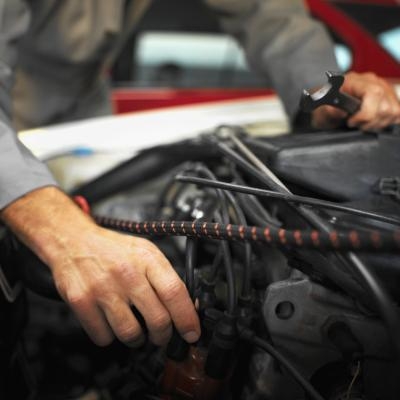
While it is fairly uncommon to need to adjust valve lash on production Chevy 350 CID small block engines, there are times -- such as after a repair -- that this adjustment is required. Valve lash is the amount of clearance (some, or none) between the intake or exhaust valve and the rocker arm. Without proper clearance, engine performance may be poor or some components could be damaged. Most engines have hydraulic lifters which require no clearance, but mechanical lifter cams do require a small amount. The basic procedure is the same for either type.
Disable the ignition system so the engine cannot start when "bumped over" by quickly engaging the starter. Remove the valve covers and set aside. Locate the "number 1" cylinder valves (driver's side, front on Chevrolet V-8s) and identify the intake and exhaust valves. The exhaust valves always correlate to the exhaust port.
Rotate the engine so the number 1 EXHAUST valve begins to OPEN (depressed down). The intake lifter is on the backside of the cam lobe (base circle) and the valve is fully closed: adjust the intake rocker arm nut so the adjacent pushrod can be just barely rotated with your index finger and thumb. This is "zero-lash," but a hydraulic lifter requires additional pre-load -- tighten the rocker nut one-half turn more. This valve is adjusted. Rotate the engine again in the same direction until the INTAKE valve is almost fully CLOSED. Perform the same procedure on the exhaust valve/rocker arm, and finish with the one-half extra turn of pre-load. Continue in the same manner for the remaining cylinders using the "Exhaust Opening, Intake Opening" (EO-IC) sequence.
Reinstall the valve covers -- using new valve cover gaskets, if necessary -- and reattach any wiring that was previously disconnected. Start the engine and observe for any leaks or unusual noises.
Disable the ignition system so the engine cannot start when "bumped over" by quickly engaging the starter. Remove the valve covers and set aside. Locate the "number 1" cylinder valves (driver's side, front on Chevrolet V-8s) and identify the intake and exhaust valves. The exhaust valves always correlate to the exhaust port.
It's uncommon for engines to have a mechanical tappet (solid lifter) camshaft unless it is an aftermarket upgrade. All procedures and individual sequences are the same except for the "zero-lash" and preload. Mechanical tappet cams require some clearance between the valve tip and rocker arm. Follow the manufacturer's recommendation for the proper amount of hot lash.
Rotate the engine to the "EO" position so the number 1 intake valve is on its base circle and fully closed. Insert a feeler gauge approximately .002 to .005 inch thicker than the recommended "hot lash" to allow for parts expansion and clearance reductions. Tighten the rocker nut so the feeler gauge blade can just barely slide in and out of the lash area between the valve tip and the rocker arm. (Set the lash cold. This is an important tip, as it is difficult top work on a hot engine, and not all settings will be consistent by the end of the procedure.) Once the cold lash is set, tighten the rocker nut. Rotate to the "IC" valve position for that cylinder and set the exhaust lash about .005 inch loose. Repeat the process for all cylinders, and reinstall the valve covers and wiring.
Start the engine and let it warm up to full operating temperature (five to 10 minutes). Listen for any unusual noises; solid lifter cams will "clatter" and this is normal. Shut off the engine and remove the valve covers. Check the valve clearances "hot." Record (in notes) the change in lash and compare it to the recommended hot lash (it should be close to recommended lash now). This will give a good idea of the precise amount of cold lash to use the next time valve lash is set by indicating how far the lash tightens up when hot.
Re-install the valve covers and wiring.